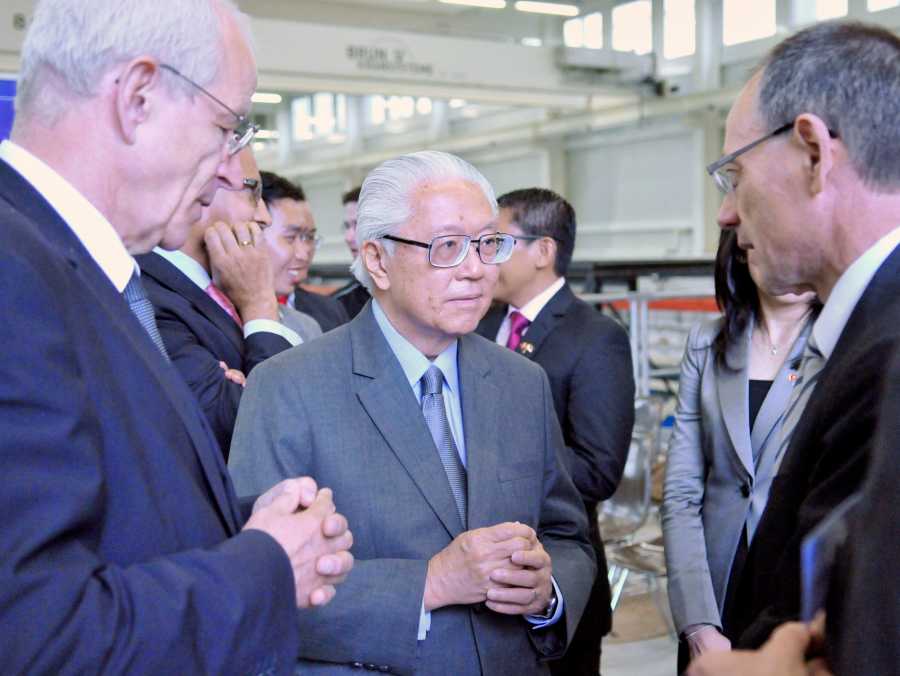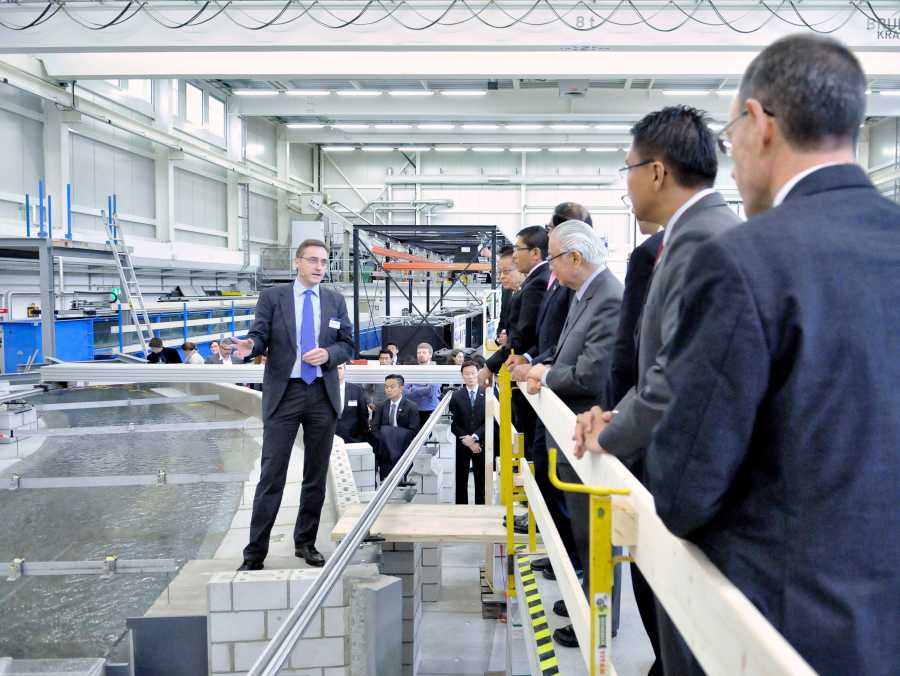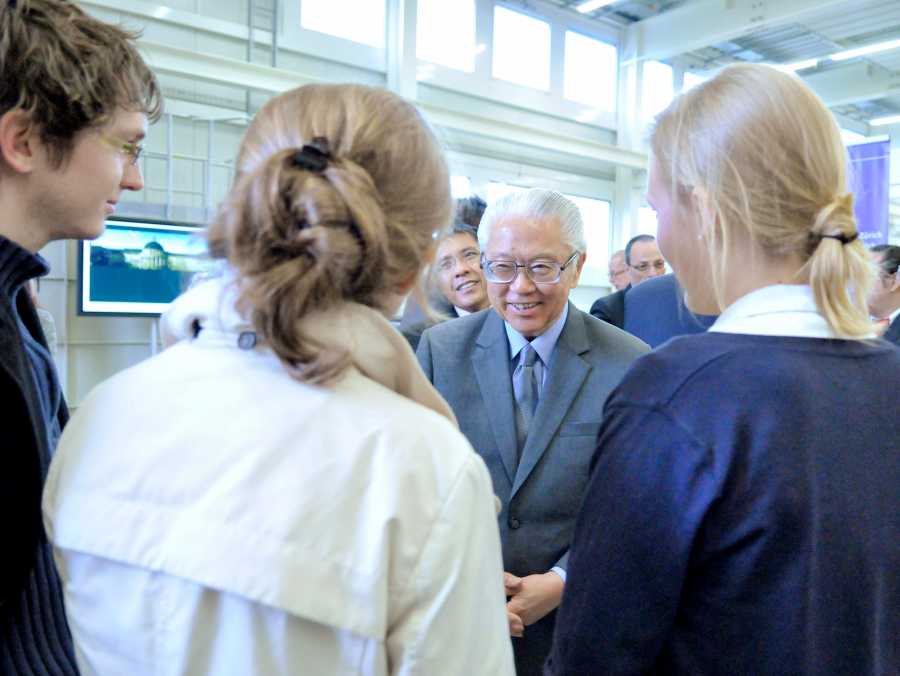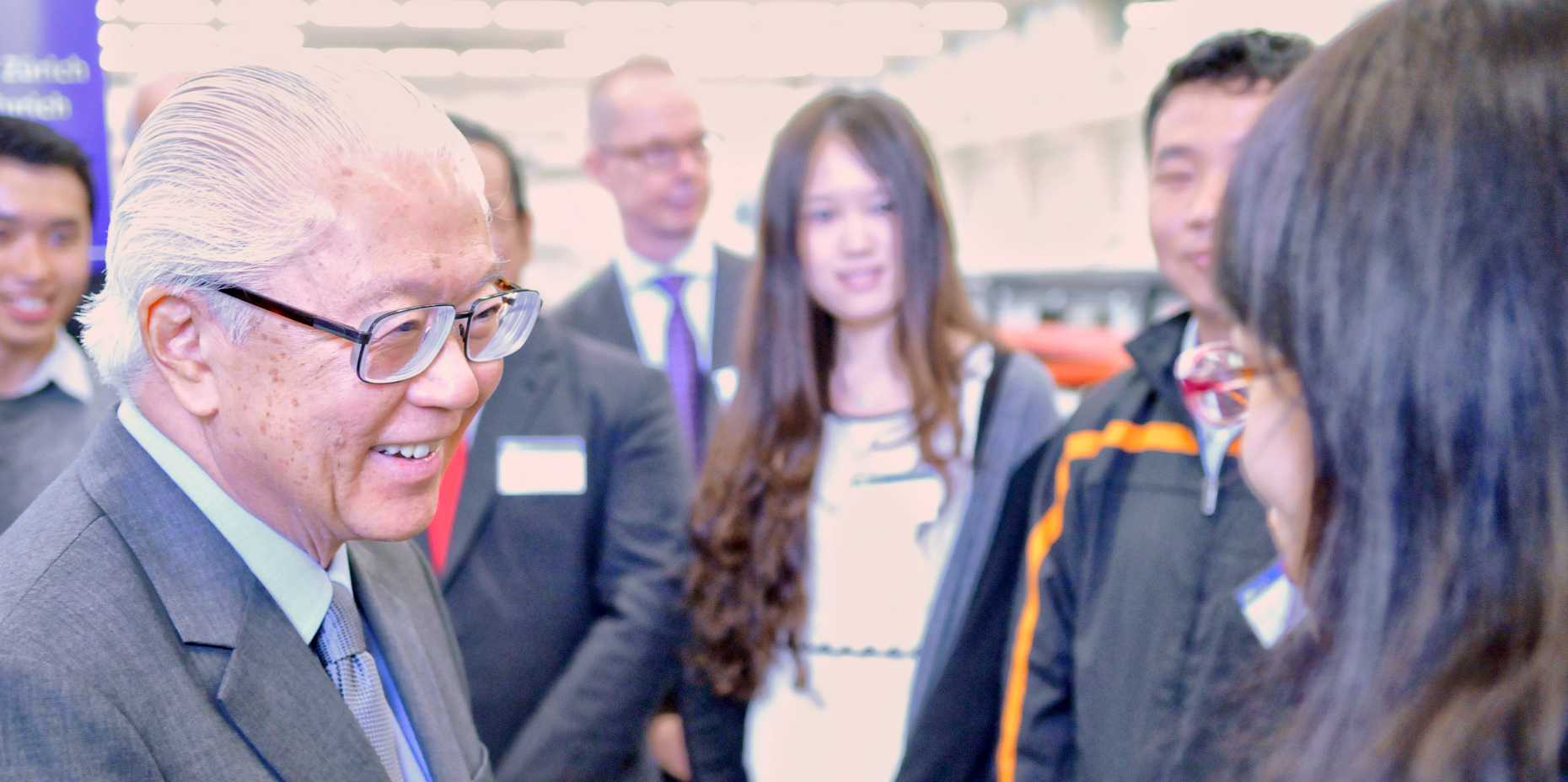Presidential visit at ETH Zurich
An experiment in which a scale model of Zürich’s main train station is flooded was at the centre of a visit of Singapore’s President, Tony Tan at ETH Zurich. Ralph Eichler, President ETH Zurich emphasized the importance of the ETH research hub in Singapore and proposed an expansion of the activities in the southeast Asian city-state.
Tony Tan, President of Singapore, disembarked under rainy conditions yesterday when he and his delegation visited the ETH campus, Hönggerberg. Water was also at the heart of an experiment in the Laboratory of Hydraulics, Hydrology, and Glaciology (VAW). Part of the research at the VAW seeks to understand and model the risks of natural hazards like tsunami and flooding events. During his visit, President Tan viewed a demonstration of a scaled simulation of a tsunami, as well as, the flooding model of Zurich’s main train station and the river Sihl. In the event that the Sihl lake damn at Einsiedeln breaks, researchers predict that the main train station and downtown areas of Zurich will be flooded in about 4.5 metres of water. The President and his delegation learned that 15,000 years ago the land where the city of Zurich now sits was under approximately 200 metres of ice. In fact, the lakes, valleys, and rivers in the Zurich area were shaped during this ice age.
While Glaciology may not be relevant research for the country of Singapore, the risk of tsunami and flooding events are important. Even the small flood events that have occurred in Singapore have a significant economic impact. Since 2010, ETH Zurich and the National Research Foundation of Singapore established a collaboration in the form of the Singapore – ETH Centre for Global Environmental Sustainability (SEC). SEC’s first research programme, the Future Cities Laboratory (FCL) is focused on sustainable urbanization.
Future Resilient Systems - Mitigating Risk
The collaboration is a way for Singapore to rapidly develop its competence as a knowledge based economy. ETH Zurich, on the other hand, benefits from the opportunity to conduct research on the complex and interdisciplinary challenges of a city-state with more than 5 million inhabitants. The Future Cities Laboratory, for example, studies the challenges of rapidly growing cities in the tropics - such research cannot easily be studied in Switzerland. “President Tan was instrumental in helping ETH Zurich set up the SEC in 2010 and we are very grateful,” said ETH-President Ralph Eichler in recognition of Tony Tan’s commitment to the centre.
Peter Edwards, ETH Professor and Director of the SEC, pointed out that urban cities are highly complex ecosystems with an ever growing risk of system failures and catastrophic events. “We can no longer think of these systems as separate and, in fact, we need new methods of understanding the resilience of cities.” Understanding the interdependencies and the infrastructure risk associated with densely populated modern urban environments are relevant to Singapore and the neighboring countries in Asia with which Singapore engages. Simulation and modeling tools as they are used and developed in research should lead to a better understanding of complex systems. “It is not just the technology, but how human beings respond to such a system,” adds Edwards. As a matter of fact, ETH Zurich has proposed a second research programme within the SEC focusing this time on creating more “risk resilient” cities.
Student Research and Urban Design in Singapore
Even though the schedule for the visit was tight, Tony Tan took the time to meet with a group of ETH Zurich students. Among them were students from Singapore who are currently completing their studies at ETH Zurich and Swiss students who had the opportunity to spend some time at the SEC. Arpad Hetey and Rahel Schenker, were two members of an 18-student research team that traveled to Singapore as part of an Urban Design course in which they studied the Rochor area. At the end of the research project, the student team presented a proposal to urban planners and city officials that incorporated existing buildings into a new design.
Hetey explained that studying at the Future Cities Laboratory enabled students not only access to researchers from different disciplines, but it also provided them the opportunity to get to know the diverse cultures in Singapore. He said, “It was great to see how the Rocher area is used. Normally, in an Urban Design course one visits an area only for a brief period of time to see the buildings, but spending time in Singapore allowed me to study how the space is used, not only at different times of the day and week, but also how the diverse cultures in Singapore use the space. Singapore is also a strategic place to discover and study urban design in the whole region.”
ETH Zurich President Elect, Lino Guzzella, looks forward to broadening cooperation between Singapore and Switzerland. “Singapore and Switzerland have so many similarities that make us natural allies in the global quest for talent.” Before returning to Singpore Tony Tan and his delegation will be meeting the President of the Swiss Confederation, Didier Burkhalter, in Berne.
Photo gallery: Visit Tony Tan
-

Interacting with Ralph Eichler (left) and Lino Guzzella (right). (Photo: Josef Kuster / ETH Zurich) -

Tony Tan is welcomed by Peter Edwards (left) and Gerhard Schmitt (middle). (Photo: Josef Kuster / ETH Zurich) -

Visit in the Laboratory of Hydraulics, Hydrology and Glaciology. (Photo: Josef Kuster / ETH Zurich) -

Visit in the Laboratory of Hydraulics, Hydrology and Glaciology. (Photo: Josef Kuster / ETH Zurich) -

Talking to students. (Photo: Josef Kuster / ETH Zurich) -

Visit in the Laboratory of Hydraulics, Hydrology and Glaciology. (Photo: Josef Kuster / ETH Zurich)

